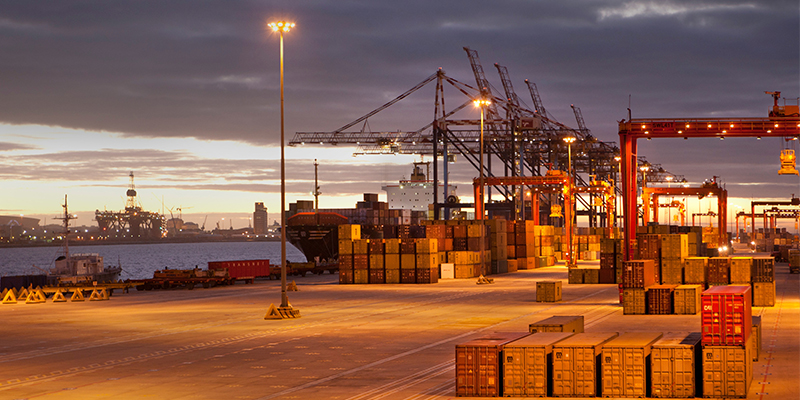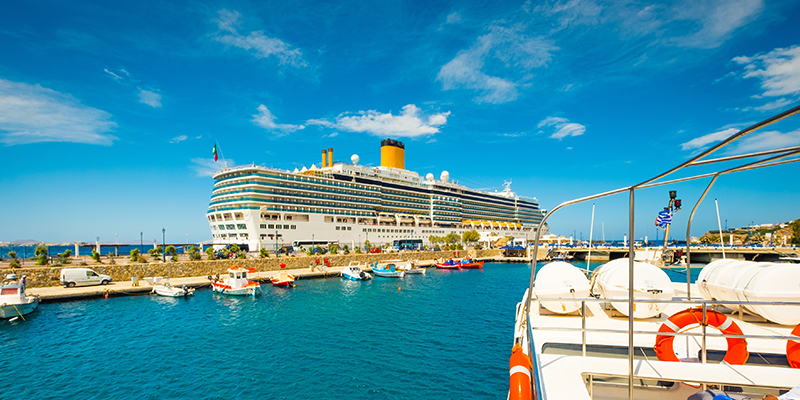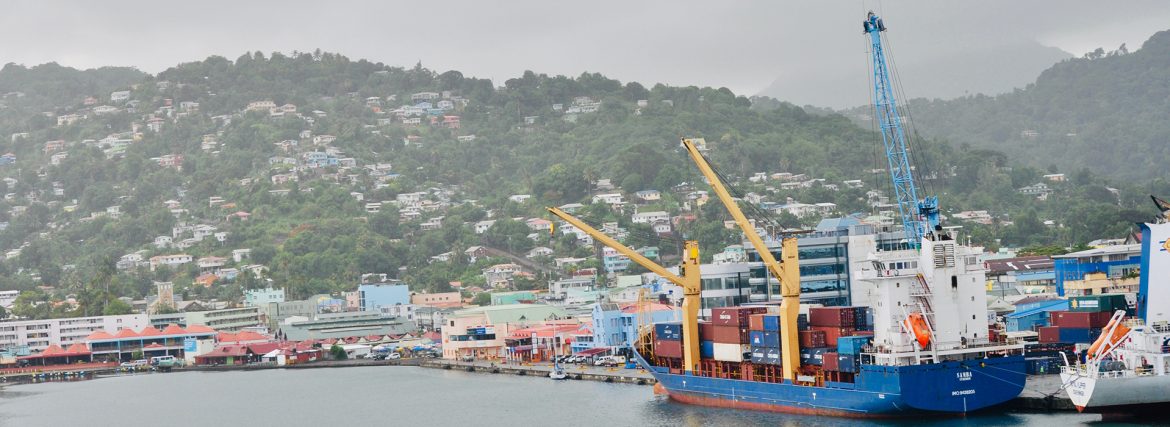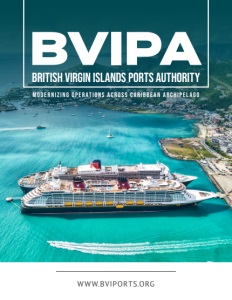Modernizing Operations Across Caribbean Archipelago
From AI-Enhanced Security Systems to Million-Visitor Cruise Operations, the BVI Ports Authority Adapts Traditional Maritime Management to Serve a Complex 60-Island Economy
The British Virgin Islands’ economy depends on a network of seven seaports scattered across an archipelago of more than 60 islands and cays. At the helm of this maritime empire is Dean Fahie, Deputy Managing Director of the BVI Ports Authority, whose operational purview encompasses everything from the 1,312-foot cruise pier that welcomes ships carrying up to 180,000 gross registered tons to the intricate web of navigation aids that guide vessels safely through Caribbean waters.
“My scope involves our operations department, which primarily handles the berthing of ships, the cargo management of cargo that comes into the BVI, our security team that manage the entire facilities of the port and also our marine department that deal with all our navigation aids and berthing of vessels at our facilities,” Fahie explains. His responsibilities also include maintenance teams across the territory’s port infrastructure.
The scale of operations under Fahie’s oversight becomes clear when examining the numbers. Port Purcell, the authority’s main cargo facility, can simultaneously accommodate 10 ships along its 244-meter quay front. The facility’s six acres of paved container storage area and 6.7-meter depth capability make it a critical gateway for goods flowing into the territory. Meanwhile, the cruise operations have proven their significance with the BVI achieving a milestone in 2024 by welcoming over 1.09 million visitors, marking only the second time since 2016 that the territory has exceeded the one million visitor mark.
Security in the Digital Age
Port security has evolved dramatically since the COVID-19 pandemic accelerated technology adoption across maritime operations. The BVI Ports Authority operates within a global environment where cybersecurity threats have become increasingly sophisticated, with industry experts warning that 2025 will bring AI-driven attacks, ransomware, and vulnerabilities in operational technology systems. For Fahie, this reality translates into continuous adaptation of security protocols across all port facilities.
“Constantly at present now we’re looking at training our security staff, updating them in terms of various aspects of security,” Fahie says. “In terms of AI, we are looking at different areas in which we can assist our security team or help the security team be more effective in terms of monitoring and securing all facilities. We have not fully opened up to that process yet, but we are looking at areas that we can go into for the future.”
The authority maintains a structured approach to security preparedness. “We have training beginning as always next month in some areas to update our security staff, keep them abreast of the threats that are there for various port facilities and to ensure that our security staff are adequately equipped to deal with the issues that may arise at various points of interest,” Fahie explains.

Cybersecurity is a parallel front in the authority’s security strategy. “We do have an IT team on staff that is actually looking at our cybersecurity to ensure that if we do have any attack that we are safeguarded from any threats and also ensure we are safeguarded from any threats that may seek to get into our system,” Fahie notes. “That is something that we’re pursuing very effectively to ensure that doesn’t happen, and our IT team are staying on top of that.”
From Supply Chain Recovery to Safe Navigation
The global supply chain disruptions that plagued maritime operations during the pandemic have largely subsided across BVI’s ports, according to Fahie’s assessment of current cargo flows. Where once delays and shortages dominated shipping schedules, the territory now experiences markedly improved reliability in goods movement. This recovery positions the BVI favorably within a Caribbean region where port handling charges remain two to three times higher than similar facilities globally.
“Things have gotten a lot better since COVID. We have seen major disruptions in our supply chain, but since COVID we have seen things have gotten much better. Our supplies are coming in on time, on schedule,” Fahie reports. “We have also seen an increase in high demand for goods to be brought into the territory. And as of now we have not seen too much of a delay; there are actually rarely any delays in stuff coming in.”
The authority has implemented digital solutions to streamline cargo collection processes, addressing inefficiencies that beset many Caribbean ports. “We are trying to ensure that on the goods that are entering into the territory, people can get them as quickly as possible,” Fahie explains. “We are looking at a number of areas in terms of software that persons can pay online, that they can log into our system to make sure that their goods are ready to be collected, or we will send them a notice saying your goods are ready to be collected, so they can come and collect, pay online, and the process at our facility will be seamless and much more quicker and efficient.”
“We are also always ensuring that our navigation aids are working. If they do need to be repaired, we take them out, put down something temporarily, but we always make sure that there is always some marker or aid there that ships can move in and out of our waters without any problems,” he adds. While the authority explores technological solutions for navigation enhancement, Fahie acknowledges they “haven’t found any solutions as yet” but remain “always open to anyone who’s willing to offer something that we can look at.”
Infrastructure, Investment, and Tourism
The BVI Ports Authority functions as a critical economic enabler for a territory where tourism and financial services generate the bulk of government revenues. With the BVI achieving over one million visitors in 2024, including 768,293 cruise passengers, the ports have proven their capacity to handle significant traffic volumes while supporting broader economic growth across key sectors.
“I would probably say that it is similar, slightly not a major increase,” Fahie says when assessing current economic conditions. “Our role is to ensure that we have the facility to ensure that whenever there’s room for improvement or development, that we are there to ensure that it grows, it is developed. But there are a number of areas that need to be addressed in terms of economic development.”
The authority positions itself strategically to accommodate economic expansion through infrastructure readiness. “Primarily we are here to ensure that as a gateway to the BVI, whatever comes in comes through our facility. We are making sure that we adequately equip ourselves and we adequately have sufficient areas or space so that if we have an influx of containers, for example, we can add free housing. If there’s a demand from a ship to do additional work, we must ensure that we are ready and in a position to assist,” Fahie explains.
Construction materials are the most significant growth sector flowing through the ports, indicating ongoing recovery and development efforts. “Primarily, I think we’re still seeing some development in construction even after the hurricane. Portions are still making several construction repairs, but that’s where we see mostly development in construction. So, we see a lot of building material coming in,” Fahie notes. “Food supplies are constantly coming in as well, containerized cargo coming in on a regular basis.”
Capital investment priorities focus heavily on expanding cargo handling capabilities and enhancing security infrastructure. “We have been refurbishing our various warehouses to ensure that we have sufficient space to accommodate the influx of cargo that we’ve seen. We’ve been building a new hazmat warehouse to deal with all our hazmat goods that are coming into the territory, so they are isolated from the regular cargo,” Fahie asserts.

Tourism infrastructure plays an equally vital role in economic development. “I feel that the role that we play in terms of cruise tourism through the CB Romney Park cruise facility in terms of the number of cruise lines that come to our territories, I think that we play a significant role in terms of our economy bringing tourists to our destination,” Fahie states. Plans for 2025 include constructing a new general cargo facility at Port Purcell to significantly enhance cargo handling capacity, alongside repairs to dock infrastructure across multiple locations.
Leading Through Complexity
Managing diverse teams across multiple port facilities and operational areas offers Fahie his most significant professional challenge. “I think the biggest challenge is always when you deal with a different variety of persons. Everybody has their own personalities and challenges, so I think that’s my biggest challenge,” Fahie acknowledges. “But I’m always able to cope and deal with the issues as they arrive.”
The satisfaction derived from successful team management provides a counterbalance to these daily challenges. “The biggest thing I enjoy at the end of the day is when it all works out, my staff is happy, they’re doing what is required, and they’re making me look good because they’re doing their share of the work and they’re making the whole organization look like we are doing something well,” Fahie explains.
Looking ahead, the authority has outlined concrete development plans for the next 18 to 24 months. “For sure we have to be building a new warehouse facility at our compound, a new general warehouse to accommodate cargo,” Fahie states. “And we are going to continue refurbishing all our facilities, whether it be the ferry facilities or the cargo facilities.”
The authority maintains measured discretion regarding longer-term strategic direction while acknowledging the need to adapt to changing economic realities. “In terms of the fiscal realities that we are seeing, in terms of our direction, I don’t think I want to say exactly what direction we’re going just yet,” Fahie says. “I know we are looking at how things are going around us, around the Caribbean, around the world, so we are still looking at our strategy in terms of strategic direction that we want to be.”
The BVI Ports Authority operates at a critical juncture where traditional maritime challenges intersect with emerging technological demands and evolving economic pressures. Under Fahie’s operational leadership, the organization continues expanding its capabilities while maintaining the delicate balance between infrastructure development, security enhancement, and service delivery across one of the Caribbean’s most geographically complex port networks.
AT A GLANCE
WHO: British Virgin Islands Ports Authority (BVIPA)
WHAT: Maritime authority managing seven seaports including cargo, ferry, and cruise facilities across the archipelago
WHERE: British Virgin Islands
WEBSITE: www.bviports.org
PREFERRED VENDORS/PARTNERS

Elroy’s Cruise Line & Tour Agency: darrellfahie@eptbvi.com
Elroy’s Cruise Line & Tour Agency specializes in shore excursion management and cruise logistics across the Virgin Islands. With a growing fleet and partnerships with local entrepreneurs, we deliver dependable service for cruise lines while creating authentic guest experiences that highlight the Territory’s culture, heritage, and natural beauty.




 This information will never be shared to third parties
This information will never be shared to third parties